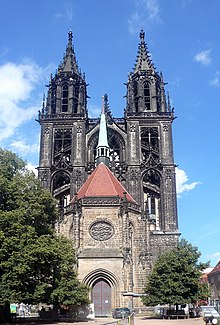Diocese of Meissen
The original diocese of Meissen (Latin: Dioecesis Misnensis ) was founded in 968. In the Electorate of Saxony it went on October 20, 1581 with the resignation of the last bishop Johann IX. von Haugwitz under. The cathedral chapter in Meissen has been preserved as a Lutheran church corporation to this day, and the Meissen Monastery also exists to this day.
history

At the suggestion of Emperor Otto , Pope John XIII approved . at the Synod of Ravenna in 967 the establishment of the three dioceses of Meißen, Merseburg and Zeitz (later Naumburg ). All three dioceses belonged to the Metropolitan Association of the Archdiocese of Magdeburg .
The Benedictine and castle chaplain Burchard , who came from the monastery of Sankt Emmeram in Regensburg , was consecrated as the first bishop of Meißen by Archbishop Adalbert of Magdeburg at Meißen Castle . The chapel in Meissen Castle became the initially modest cathedral of the diocese. The patron saints of the cathedral and diocese were the evangelists John and Donatus of Arezzo .
Like the other bishoprics mentioned, Meissen was founded by the Ottonian emperors for the mission of the Slavic countries between the Elbe , Saale and Oder . At the same time, the diocese was intended to strengthen royal rule in the newly conquered areas east of the Saale. So it was no coincidence that Meißen Castle, from where the royal margraves ruled, also became the seat of a bishopric. The change in cooperation and competition between the margraves and the bishops has had a decisive impact on the history of the Meissen diocese.
In the 12th and 13th centuries, 72 monasteries were founded in the area of the diocese, in particular by Cistercian and Franciscan monasteries .
Among the numerous donations that the diocese in Saxony and Upper Lusatia received from the kings and margraves, the properties in the Wurzen area and in the Stolpen - Bischofswerda area were of outstanding importance. In these two areas, the bishops and the cathedral chapter succeeded in the 14th century in consolidating their numerous rights and possessions to such an extent that they actually became rulers there (in the so-called Hochstift Meissen ). However, the status of imperial immediacy was always denied to the bishops by the Meissen margraves. And indeed, the Meissen Bishops are rarely as spiritual princes on the diets were represented.
1399 the diocese of Pope Boniface IX. declared exempt and directly subordinated to the Holy See . Since the founding of the diocese, the bishops resided on the Meißener Burgberg in their own castle house next to the Margrave's castle , and since the beginning of the 15th century at Stolpen Castle .
With the introduction of the Reformation in 1539, beginning in the cathedral church, the diocese gradually lost the Catholic diocesan area. After the resignation of the last bishop and the election of the Saxon elector as administrator and bishop of Electoral Saxony in 1581, the old diocese of Meissen came to an end. The associated monasteries and monasteries were secularized . Only in the two Lausitzes belonging to Bohemia did the remains of the Meissen diocese remain Catholic until its re-establishment and were subordinated to an administrator based in Bautzen at St. Petri Cathedral . In 1539 the Meissen Cathedral became a Lutheran church; today it is the sermon church for the regional bishop of the Evangelical Lutheran regional church of Saxony .
Rebuilding
In 1921 the Catholic diocese of Meissen was founded by Pope Benedict XV. rebuilt with headquarters in Bautzen . It initially had its cathedral in Bautzen Cathedral . On November 15, 1979 the name was changed to the Diocese of Dresden-Meißen , and the following year, on March 25, 1980, Bishop Gerhard Schaffran moved the bishopric to Dresden . Since then, the Catholic Court Church in Dresden has acted as the new main cathedral, while Bautzner Dom is a co- cathedral .
literature
- Willi Rittenbach, Siegfried Seifert : History of the Bishops of Meissen 968–1581 (= studies of the Catholic diocese and monastery history. 8). Leipzig 1965.
- André Thieme : The foundation of the Meißen diocese 1050 years ago. in: Sächsische Heimatblätter , 64 (2018) 4, pp. 374–376
Web link
See also
Individual evidence
- ↑ Jens Bulisch: The Diocese of Meißen in the Reformation . St. Benno Verlag , Leipzig 2016, ISBN 978-3-7462-4757-1 , p. 98 .
- ↑ a b Jens Bulisch: The Diocese of Meißen in the Reformation . St. Benno Verlag , Leipzig 2016, ISBN 978-3-7462-4757-1 , p. 16 ( hugendubel.de [PDF]).
- ↑ Enno Bünz: The Wettins, the Reformation and the Diocese of Meißen (1485-1581) . In: Claudia Kund, André Thieme (Ed.): A treasure not of gold. Benno von Meissen. Saxony's first saint . Catalog for the special exhibition. Michael Imhof Verlag, Petersberg 2017, ISBN 978-3-7319-0451-9 , p. 268 .


